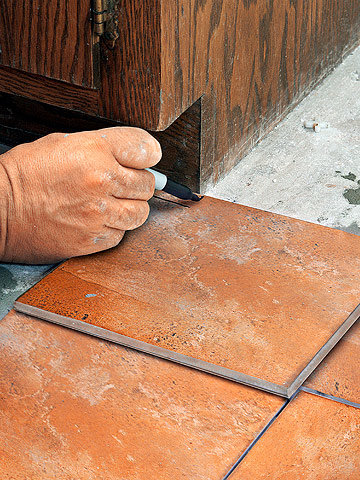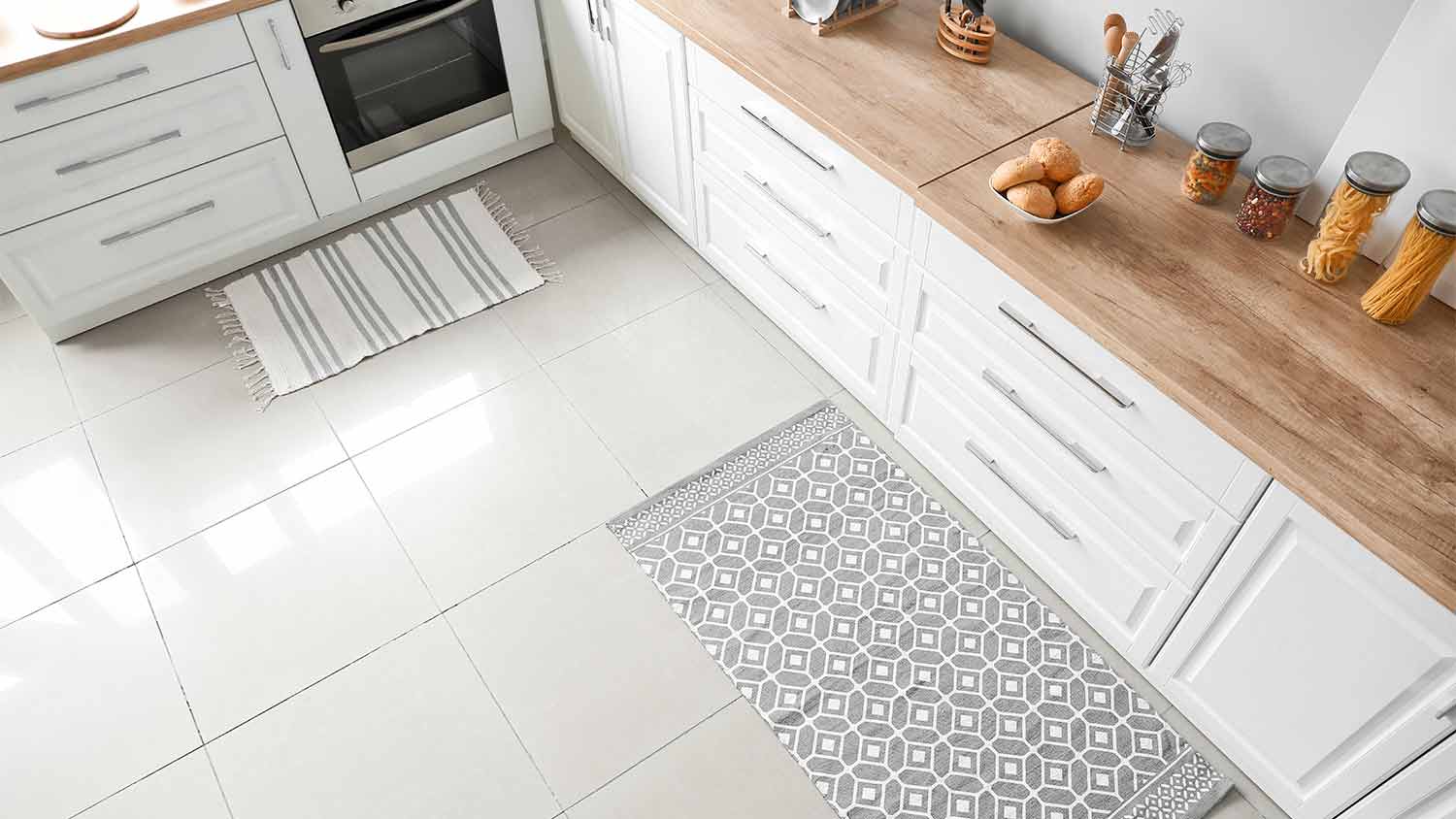Install kitchen cabinets first, then the tile floor. This prevents damage to the tiles during cabinet installation.
Choosing whether to install kitchen cabinets or tile floor first is crucial for a successful kitchen remodel. Starting with the cabinets ensures they sit directly on the subfloor, providing stability and avoiding future tile damage. This approach also allows for easier and more accurate tile cuts around the cabinet edges.
Additionally, it prevents potential height issues that might arise if the floor is done first. Proper sequencing can save time, effort, and costs in the long run. Careful planning and execution create a more seamless and professional finish, enhancing the overall look and functionality of your kitchen space.

Credit: www.cabinetcity.net
Table of Contents
TogglePros Of Installing Cabinets First
Deciding whether to install kitchen cabinets or the tile floor first can be tricky. Installing cabinets first has several benefits. Here are a few key reasons why this approach might be best for your kitchen renovation.
Cabinet Stability
Installing cabinets first ensures they are stable. They will be securely anchored to the wall and floor. This stability prevents any movement or shifting. With a solid base, your cabinets will last longer.
Stability is crucial for heavy cabinets. It ensures they hold all your kitchen items safely. This approach also makes sure the cabinets align perfectly with your walls and countertops.
Avoiding Tile Damage
Installing cabinets first helps in avoiding tile damage. Tiles can crack or chip easily during the cabinet installation process. By installing cabinets first, you minimize the risk of damaging your beautiful tile floor.
Heavy cabinets can also place a lot of pressure on tiles. This pressure can lead to cracks over time. Installing cabinets first ensures that your tiles remain in pristine condition.
Below is a table summarizing the pros of installing cabinets first:
| Pros | Details |
|---|---|
| Cabinet Stability | Securely anchored, prevents movement, ensures longevity |
| Avoiding Tile Damage | Reduces risk of cracks, keeps tiles in good condition |
Cons Of Installing Cabinets First
When planning a kitchen remodel, the order of installation matters. Choosing to install cabinets before tile flooring can lead to several issues. These problems can affect the final look and durability of your kitchen. Let’s explore the drawbacks.
Restricted Tile Layout
Installing cabinets first limits your tile layout options. The cabinets cover a significant portion of the floor. This restriction can make it hard to create a seamless, continuous tile pattern.
With cabinets already in place, tile cuts may be required. These cuts can result in an uneven and unprofessional appearance. Matching tiles to fit around cabinets can also be time-consuming.
| Issue | Description |
|---|---|
| Limited Design | Cabinets restrict tile pattern choices. |
| Extra Cuts | Tiles need cutting to fit around cabinets. |
| Time-Consuming | Fitting tiles around cabinets takes longer. |
Potential Future Repairs
Cabinets installed before tiles can complicate future repairs. If tiles under cabinets crack, fixing them becomes difficult. Removing cabinets to replace a few tiles can be costly and inconvenient.
Future appliance upgrades may also pose problems. New appliances might not fit if the floor is uneven. This can result from tile height differences caused by cabinet installation.
- Repair Challenges: Fixing tiles under cabinets is tough.
- Costly and Time-Consuming: Removing cabinets for tile repair adds expenses.
- Appliance Fit Issues: New appliances might not fit due to uneven flooring.
Pros Of Installing Tile Floor First
Deciding whether to install kitchen cabinets or tile floor first can be tough. There are some significant advantages to laying tile floor first. These benefits can impact the overall look and functionality of your kitchen.
Seamless Look
A seamless look is one of the biggest advantages. Installing tile floor first means the tiles extend beneath the cabinets. This creates a clean, uninterrupted flow throughout the kitchen.
This approach eliminates visible gaps or transitions between the cabinets and the floor. It ensures a polished and professional appearance. Your kitchen will look more cohesive and spacious.
Easier Future Modifications
Another significant benefit is easier future modifications. Installing the tile floor first simplifies changes to your kitchen layout later. You won’t need to worry about matching new tiles with existing ones.
This flexibility can save time and money in the long run. Replacing cabinets becomes less complicated. You can update your kitchen without worrying about damaging the floor.
Here’s a quick comparison of the benefits:
| Benefit | Explanation |
|---|---|
| Seamless Look | Creates a clean, uninterrupted flow throughout the kitchen. |
| Easier Future Modifications | Simplifies changes to your kitchen layout later. |

Credit: mads.media
Cons Of Installing Tile Floor First
Choosing the order for kitchen renovations is crucial. Some homeowners debate whether to install kitchen cabinets or tile floor first. Installing the tile floor first can have significant drawbacks. Let’s explore the cons of this approach.
Higher Costs
Installing the tile floor first can be more expensive. You will need to buy more tiles to cover the entire floor. The extra tiles increase the project cost. Also, you might pay more for labor. Workers need to be extra careful to avoid damaging the tiles.
Risk Of Tile Damage
Cabinet installation can damage the tile floor. Heavy cabinets can crack or chip the tiles. Workers might drop tools or materials. These accidents can lead to costly repairs. Also, moving large appliances can scratch the tiles. This creates more expenses and hassles.
Expert Opinions
Choosing whether to install kitchen cabinets or the tile floor first can be tricky. We sought insights from experts to help you decide.
Contractor Insights
Contractors often have a practical viewpoint. Many contractors prefer installing tile floors first. This method ensures a smooth and even surface.
Here are key reasons contractors suggest tile floors first:
- Prevents damage to cabinets during floor installation.
- Ensures a level and consistent base.
- Allows for easier future repairs or replacements.
Some contractors may have different preferences based on specific project needs.
Designer Perspectives
Designers focus on aesthetics and functionality. Many designers prefer installing kitchen cabinets first. This approach allows for a more tailored look.
Here are reasons designers favor cabinets first:
- Helps in achieving a precise fit and finish.
- Prevents potential damage to the floor from heavy cabinets.
- Offers flexibility in choosing different flooring materials.
Designers might adjust their approach based on the design vision and client needs.

Credit: www.angi.com
Material Considerations
Choosing between installing kitchen cabinets or tile flooring first involves many factors. One key aspect is the material used. The durability of your tiles and the weight of your cabinets play significant roles. Understanding these aspects can help you make an informed decision.
Tile Durability
Tiles come in different materials such as ceramic, porcelain, and stone. Each type offers various levels of durability and maintenance needs. Ceramic tiles are generally cheaper but can crack under heavy weight. Porcelain tiles are more durable and less porous, making them a better choice for high-traffic areas.
Stone tiles are highly durable but require sealing to prevent stains. Consider the traffic in your kitchen and the potential for spills. This will help you choose the best type of tile for your needs.
Cabinet Weight
Kitchen cabinets come in different materials like wood, laminate, and metal. The weight of these materials can affect your flooring choice. Heavy cabinets can stress the tiles, leading to cracks or shifts.
A table showing common cabinet materials and their average weights:
| Material | Average Weight (lbs) |
|---|---|
| Wood | 50-100 |
| Laminate | 30-60 |
| Metal | 70-120 |
Understanding the weight of your cabinets helps in choosing the right tile. If your cabinets are heavy, opt for more durable tiles like porcelain or stone.
Practical Tips
Deciding whether to install kitchen cabinets or tile floor first can be tricky. Here are some practical tips to guide you through this process. Follow these steps to ensure a smooth and efficient renovation.
Measuring And Planning
Accurate measuring and planning are essential for a successful kitchen renovation. Begin by measuring the entire kitchen space. Use a tape measure and note down all dimensions. Create a detailed floor plan that includes cabinets and tile areas.
| Step | Description |
|---|---|
| 1 | Measure the kitchen length and width. |
| 2 | Note the dimensions of cabinets and appliances. |
| 3 | Create a scaled floor plan. |
Use a level to ensure surfaces are even. This prevents future issues with tile alignment and cabinet installation.
Protecting Your Investment
Protecting your investment is crucial during renovations. Follow these tips to safeguard your new kitchen.
- Cover floors with protective materials during cabinet installation.
- Use edge protectors to prevent damage to cabinets.
- Store tiles and cabinets in a dry area before installation.
Install cabinets before flooring for easier adjustments. If you choose to install flooring first, ensure it’s well-covered to avoid damage.
Frequently Asked Questions
Which Should Be Installed First, Cabinets Or Tile?
Install cabinets first to avoid damaging tiles during cabinet installation.
Does Cabinet Installation Affect Floor Tiles?
Yes, cabinets installed after tiling can crack or damage tiles.
Can I Install Cabinets On Top Of Tiles?
Yes, but it’s less common and can complicate repairs.
Are There Benefits To Installing Tile First?
Yes, installing tiles first allows for easier future tile replacement.
How Does Cabinet Weight Impact Tile Flooring?
Heavy cabinets can cause tiles to crack or shift over time.
What Is The Best Sequence For Kitchen Renovation?
Typically, install cabinets first, then tile flooring to protect tiles.
Does Tile Installation Cost Differ By Sequence?
Yes, tiling around cabinets can be less costly and time-consuming.
Can Tile Flooring Support Heavy Kitchen Cabinets?
Yes, but ensure proper subfloor preparation to prevent damage.
Should I Tile Under Kitchen Appliances?
Tile under appliances for a seamless look and easier appliance movement.
What Materials Are Best For Kitchen Floors?
Ceramic, porcelain, and stone tiles are durable and easy to clean.
Conclusion
Choosing whether to install kitchen cabinets or tile floor first depends on your project’s needs. Assess your priorities, budget, and timeline. Both approaches have pros and cons. Make an informed decision to ensure a smooth renovation process. Your kitchen will be both functional and beautiful with the right strategy.


